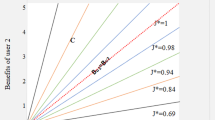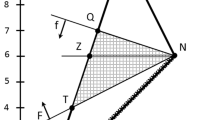Abstract
We consider multi-objective optimization problems where the decision maker (DM) has equity concerns. We assume that the preference model of the DM satisfies properties related to inequity-aversion, hence we focus on finding nondominated solutions in line with the properties of inequity-averse preferences, namely the equitably nondominated solutions. We discuss two algorithms for finding good subsets of equitably nondominated solutions. The first approach is an extension of an interactive approach developed for finding the most preferred nondominated solution when the utility function is assumed to be quasiconcave. We find the most preferred equitably nondominated solution when the utility function is assumed to be symmetric quasiconcave. In the second approach we generate an evenly distributed subset of the set of equitably nondominated solutions to be considered further by the DM. We show the computational feasibility of the two algorithms on equitable multi-objective knapsack problem, in which projects in different categories are to be funded subject to a limited budget. We perform experiments to show and discuss the performances of the algorithms.





Similar content being viewed by others
References
Alves, M. J., & Clímaco, J. (2007). A review of interactive methods for multiobjective integer and mixed-integer programming. European Journal of Operational Research, 180(1), 99–115.
Antunes, C. H., Alves, M. J., & Clímaco, J. (2016). Multiobjective linear and integer programming. Berlin: Springer.
Baatar, D., & Wiecek, M. M. (2006). Advancing equitability in multiobjective programming. Computers & Mathematics with Applications, 52(1–2), 225–234.
Bazgan, C., Hugot, H., & Vanderpooten, D. (2009). Solving efficiently the 0–1 multi-objective knapsack problem. Computers & Operations Research, 36(1), 260–279.
Beamon, B. M., & Balcik, B. (2008). Performance measurement in humanitarian relief chains. International Journal of Public Sector Management, 21(1), 4–25.
Ceyhan, G., Köksalan, M., & Lokman, B. (2019). Finding a representative nondominated set for multi-objective mixed integer programs. European Journal of Operational Research, 272(1), 61–77.
Clímaco, J., Ferreira, C., & Captivo, M. E. (1997). Multicriteria integer programming: An overview of the different algorithmic approaches. In J. Clímaco (Ed.), Multicriteria analysis (pp. 248–258). Springer.
Deb, K. (2014). Multi-objective optimization. In E. Burke, & G. Kendall (Eds.), Search methodologies (pp. 403–449). Springer.
Ehrgott, M., & Gandibleux, X. (2000). A survey and annotated bibliography of multiobjective combinatorial optimization. OR-Spektrum, 22(4), 425–460.
Figueira, J. R., Paquete, L., Simões, M., & Vanderpooten, D. (2013). Algorithmic improvements on dynamic programming for the bi-objective \(\{\)0, 1\(\}\) knapsack problem. Computational Optimization and Applications, 56(1), 97–111.
Hazen, G. (1983). Preference convex unanimity in multiple criteria decision making. Mathematics of operations research, 8(4), 505–516.
Holzmann, T., & Smith, J. (2018). Solving discrete multi-objective optimization problems using modified augmented weighted tchebychev scalarizations. European Journal of Operational Research, 271(2), 436–449.
Karsu, Ö. (2013). Using holistic multicriteria assessments: The convex cones approach. In J. J. Cochran, L. A. Cox Jr., P. Keskinocak, J. P. Kharoufeh, & J. C. Smith (Eds.), Wiley encyclopedia of operations research and management science (pp. 1–14). Wiley.
Karsu, Ö., & Morton, A. (2014). Incorporating balance concerns in resource allocation decisions: A bi-criteria modelling approach. Omega, 44, 70–82.
Karsu, Ö., & Morton, A. (2015). Inequity averse optimization in operational research. European Journal of Operational Research, 245(2), 343–359.
Karsu, Ö., Morton, A., & Argyris, N. (2018). Capturing preferences for inequality aversion in decision support. European Journal of Operational Research, 264(2), 686–706.
Kellerer, H., Pferschy, U., & Pisinger, D. (2003). Knapsack problems. 2004. Berlin: Springer.
Kirlik, G., & Sayın, S. (2014). A new algorithm for generating all nondominated solutions of multiobjective discrete optimization problems. European Journal of Operational Research, 232(3), 479–488.
Klamroth, K., & Wiecek, M. M. (2000). Dynamic programming approaches to the multiple criteria knapsack problem. Naval Research Logistics, 47(1), 57–76.
Köksalan, M. (2008). Multiobjective combinatorial optimization: Some approaches. Journal of Multi-Criteria Decision Analysis, 15(3–4), 69–78.
Korhonen, P., Wallenius, J., & Zionts, S. (1984). Solving the discrete multiple criteria problem using convex cones. Management Science, 30(11), 1336–1345.
Kostreva, M. M., & Ogryczak, W. (1999). Linear optimization with multiple equitable criteria. RAIRO-Operations Research, 33(3), 275–297.
Kostreva, M. M., Ogryczak, W., & Wierzbicki, A. (2004). Equitable aggregations and multiple criteria analysis. European Journal of Operational Research, 158(2), 362–377.
Laumanns, M., Thiele, L., & Zitzler, E. (2006). An efficient, adaptive parameter variation scheme for metaheuristics based on the epsilon-constraint method. European Journal of Operational Research, 169(3), 932–942.
Lokman, B., & Köksalan, M. (2013). Finding all nondominated points of multi-objective integer programs. Journal of Global Optimization, 57(2), 347–365.
Lokman, B., & Köksalan, M. (2014). Finding highly preferred points for multi-objective integer programs. IIE Transactions, 46(11), 1181–1195.
Lokman, B., Köksalan, M., Korhonen, P. J., & Wallenius, J. (2016). An interactive algorithm to find the most preferred solution of multi-objective integer programs. Annals of Operations Research, 245(1–2), 67–95.
Mansour, I. B., & Alaya, I. (2015). Indicator based ant colony optimization for multi-objective knapsack problem. Procedia Computer Science, 60, 448–457.
Mansour, I. B., Alaya, I., & Tagina, M. (2019). A gradual weight-based ant colony approach for solving the multiobjective multidimensional knapsack problem. Evolutionary Intelligence, 12(2), 253–272.
Mansour, I. B., Basseur, M., & Saubion, F. (2018). A multi-population algorithm for multi-objective knapsack problem. Applied Soft Computing, 70, 814–825.
Mavrotas, G., & Diakoulaki, D. (1998). A branch and bound algorithm for mixed zero-one multiple objective linear programming. European Journal of Operational Research, 107(3), 530–541.
Mavrotas, G., & Florios, K. (2013). An improved version of the augmented \(\varepsilon \)-constraint method (augmecon2) for finding the exact pareto set in multi-objective integer programming problems. Applied Mathematics and Computation, 219(18), 9652–9669.
Ogryczak, W., & Śliwiński, T. (2003). On solving linear programs with the ordered weighted averaging objective. European Journal of Operational Research, 148(1), 80–91.
Özlen, M., & Azizoğlu, M. (2009). Multi-objective integer programming: A general approach for generating all non-dominated solutions. European Journal of Operational Research, 199(1), 25–35.
Ozlen, M., Burton, B. A., & MacRae, C. A. (2014). Multi-objective integer programming: An improved recursive algorithm. Journal of Optimization Theory and Applications, 160(2), 470–482.
Sayın, S. (2000). Measuring the quality of discrete representations of efficient sets in multiple objective mathematical programming. Mathematical Programming, 87(3), 543–560.
Sen, A., & Foster, J. (1997). On economic inequality. Oxford: Clarendon Press. (expanded Edition).
Shorrocks, A. (1983). Ranking income distributions. Economica, 50, 3–17.
Silvano, M., & Paolo, T. (1990). Knapsack problems: Algorithms and computer implementations. Wiley.
Steuer, R. (1986). Multiple criteria optimization: Theory, computation, and application. New York: Willey.
Sylva, J., & Crema, A. (2004). A method for finding the set of non-dominated vectors for multiple objective integer linear programs. European Journal of Operational Research, 158(1), 46–55.
Ulungu, E. L., & Teghem, J. (1994). Multi-objective combinatorial optimization problems: A survey. Journal of Multi-Criteria Decision Analysis, 3(2), 83–104.
Visée, M., Teghem, J., Pirlot, M., & Ulungu, E. L. (1998). Two-phases method and branch and bound procedures to solve the bi-objective knapsack problem. Journal of Global Optimization, 12(2), 139–155.
White, D. (1990). A bibliography on the applications of mathematical programming multiple-objective methods. Journal of the Operational Research Society, 41, 669–691.
Zhang, W., & Reimann, M. (2014). A simple augmented\(\varepsilon \)-constraint method for multi-objective mathematical integer programming problems. European Journal of Operational Research, 234(1), 15–24.
Author information
Authors and Affiliations
Corresponding author
Additional information
Publisher's Note
Springer Nature remains neutral with regard to jurisdictional claims in published maps and institutional affiliations.
Appendices
Appendices
Proof of Theorem 6
Proof
PART 1: We will show that if \(z \in \bar{{CD_{Symm}}}(z^{m},z^{k})\) (it is equitably dominated by \(C(\overrightarrow{z^{m}};\overrightarrow{z^{k}}))\) then Eqs. 7 and 8 hold. Let z be cone dominated, i.e. \( \exists \) \(\mu \ge 0: z^{\prime }=\overrightarrow{z^k}+\mu (\overrightarrow{z^k}-\overrightarrow{z^m}) \) and \(z \preceq _{e} z'\). Then by Theorem 5, \(\sum _{i=1}^{t}\overrightarrow{z_{i}} \le \sum _{j \in a}z^{\prime }_j \quad \forall t, \forall a \in K^t\). That is:
Note that \(K^t=K^t_{km} \cup K^t_{mk}\) and \(K^t_{km} \cap K^t_{mk}=\emptyset \quad \forall t\). Then:
Since \(\sum _{j \in b} (\overrightarrow{z_j^k}-\overrightarrow{z_j^m}) \le 0\) by definition, Eq. 32 can be rewritten as:
Since \(\mu \ge 0\) and \(\sum _{j \in b} (\overrightarrow{z_j^m}-\overrightarrow{z_j^k}) \ge 0\), \(\sum _{j \in b}\overrightarrow{z_j^k}-\sum _{i=1}^{t_1}\overrightarrow{z_{i}} \ge 0 \quad \forall t_1\in P\text {, }\forall b \in K^{t_1}_{mk}\) should hold. That is, Eq. 7 holds.
Equation 33 can be rewritten as:
Since \(\sum _{l \in c} (\overrightarrow{z_l^k}-\overrightarrow{z_l^m}) > 0\) and \(\sum _{j \in b} (\overrightarrow{z_j^m}-\overrightarrow{z_j^k}) \ge 0\), from Eqs. 34 and 35 we have the following (by multiplying Eq. 34 by \(\sum _{l \in c} (\overrightarrow{z_l^k}-\overrightarrow{z_l^m})\) and Eq. 35 by \(\sum _{j \in b} (\overrightarrow{z_j^m}-\overrightarrow{z_j^k})\)):
\((\sum _{i=1}^{t_2}\overrightarrow{z_{i}}-\sum _{l \in c}\overrightarrow{z_l^k}) (\sum _{j \in b}(\overrightarrow{z_j^m}-\overrightarrow{z_j^k}) ) \le \mu (\sum _{l \in c} (\overrightarrow{z_l^k}-\overrightarrow{z_l^m}))(\sum _{j \in b} (\overrightarrow{z_j^m}-\overrightarrow{z_j^k})) \le (\sum _{j \in b}\overrightarrow{z_j^k}-\sum _{i=1}^{t_1}\overrightarrow{z_{i}})(\sum _{l \in c} (\overrightarrow{z_l^k}-\overrightarrow{z_l^m})) \forall t_1 \in P, \forall t_2 \in P, \forall b \in K^{t_1}_{mk}, \forall c \in K^{t_2}_{km} \)
PART 2: Now suppose that Eqs. 7 and 8 hold. We will show that z is cone dominated, i.e. \(\exists \mu \ge 0 : z \preceq _{e} ( \overrightarrow{z^k}+\mu (\overrightarrow{z^k}-\overrightarrow{z^m}))\). Note that \(K^{t_1}_{mk}\) consists of two subsets \(K^{t_1}_{strict\_mk}\) and \( K^{t_1}_{equal\_mk}\) as follows: \(\sum _{j \in b} \overrightarrow{z^m_{j}} > \sum _{j \in b} \overrightarrow{z^k_{j}}\) for all \( b \in K^{t_1}_{strict\_mk} \) and \(\sum _{j \in b} \overrightarrow{z^m_{j}} = \sum _{j \in b} \overrightarrow{z^k_{j}}\) for all \( b \in K^{t_1}_{equal\_mk} \).
Since for \(b\in K^{t_1}_{strict\_mk}\) we have \(\sum _{j \in b}(\overrightarrow{z^m_j} - \overrightarrow{z^k_j} )>0\) and for \(c\in K^{t_2}_{km}\) \(\sum _{l \in c}(\overrightarrow{z^k_l} - \overrightarrow{z^m_l} )>0\) , Eq. 8 implies the following:
We will find a \(\mu \ge 0\) that makes z equitably dominated by \(\overrightarrow{z^k}+\mu (\overrightarrow{z^k}-\overrightarrow{z^m}))\). One can define
Since \((\sum _{j \in b}\overrightarrow{z^k_j}-\sum _{i=1}^t\overrightarrow{z_i}) \ge 0\) (see Eq. 7) and \(\sum _{j \in b} (\overrightarrow{z^m_j} -\overrightarrow{z^k_j} )>0\) for all \(b\in K_{strict\_mk}\) , \({\bar{\mu }}\ge 0\) holds.
Note that the following holds for this \({\bar{\mu }}\):
\(\sum _{i=1}^{t_2}\overrightarrow{z_i}\le \sum _{l \in c}\overrightarrow{z^k_l}+{\bar{\mu }}\sum _{l \in c} (\overrightarrow{z^k_l} - \overrightarrow{z^m_l} ) \text { } \forall t_2 \in P \text {, } \forall c\in K^{t_2}_{km}\)(From the left side of Eq. 38)
\(\sum _{i=1}^{t_1}\overrightarrow{z_i} \le \sum _{j \in b}\overrightarrow{z^k_j}+{\bar{\mu }} \sum _{j \in b} (\overrightarrow{z^k_j} - \overrightarrow{z^m_j} )\text { } \forall t_1\in P \text {, } \forall b\in K^{t_1}_{strict\_mk}\)(From the right side of Eq. 38).
\(\sum _{i=1}^t\overrightarrow{z_i} \le \sum _{j \in b}\overrightarrow{z^k_j}+{\bar{\mu }} \sum _{j \in b} (\overrightarrow{z^k_j} -\overrightarrow{z^m_j})=\sum _{j \in b}\overrightarrow{z^k_j} \text { } \forall t\in P \text {, } \forall b\in K^t_{equal\_mk}\) (From condition 7).
Note that \(K^t= K^t_{strict\_mk}\cup K^t_{equal\_mk} \cup K^t_{km}\). Therefore the conditions of Theorem 5 are satisfied, making z equitably dominated by \(\overrightarrow{z^k}+{\bar{\mu }}(\overrightarrow{z^k}-\overrightarrow{z^m})\). \(\square \)
Proof of Proposition 7
For \(P=\lbrace 1,2,\cdots ,p\rbrace \):
and \(\overrightarrow{z}_1 \le \overrightarrow{z}_2\le \cdots \le \overrightarrow{z}_p\)
We will prove Proposition 7 by induction. The base case is at \(p=2\) where \(P=\lbrace 1,2\rbrace \). To show that Proposition 7 holds for the base case, we need to show that \(y_2\ge 2y_1\).
Since by definition \(y_1=\overrightarrow{z}_1\) and \(y_2=\overrightarrow{z}_1+\overrightarrow{z}_2\) where \(\overrightarrow{z}_2 \ge \overrightarrow{z}_1\), then \(y_2=\overrightarrow{z}_1+\overrightarrow{z}_1+\epsilon \ge 2\overrightarrow{z}_1=2y_1\) where \(\epsilon \ge 0\). Hence \(y_2\ge 2y_1\).
Hypothesis 1
Assume that Proposition 7 holds for \(p=s\).
To complete the proof, we need to show that Proposition 7 holds for \(p=s+1\). Due to Hypothesis 1, we just have to show that Proposition 7 holds for all \((j,s+1): 1 \le j \le s\).
\(jy_s\ge sy_j\) for all \(1\le j \le s\) (Due to Hypothesis 1)
Therefore, Proposition 7 holds for any p.
Rights and permissions
About this article
Cite this article
Bashir, B., Karsu, Ö. Solution approaches for equitable multiobjective integer programming problems. Ann Oper Res 311, 967–995 (2022). https://doi.org/10.1007/s10479-020-03613-9
Published:
Issue Date:
DOI: https://doi.org/10.1007/s10479-020-03613-9




